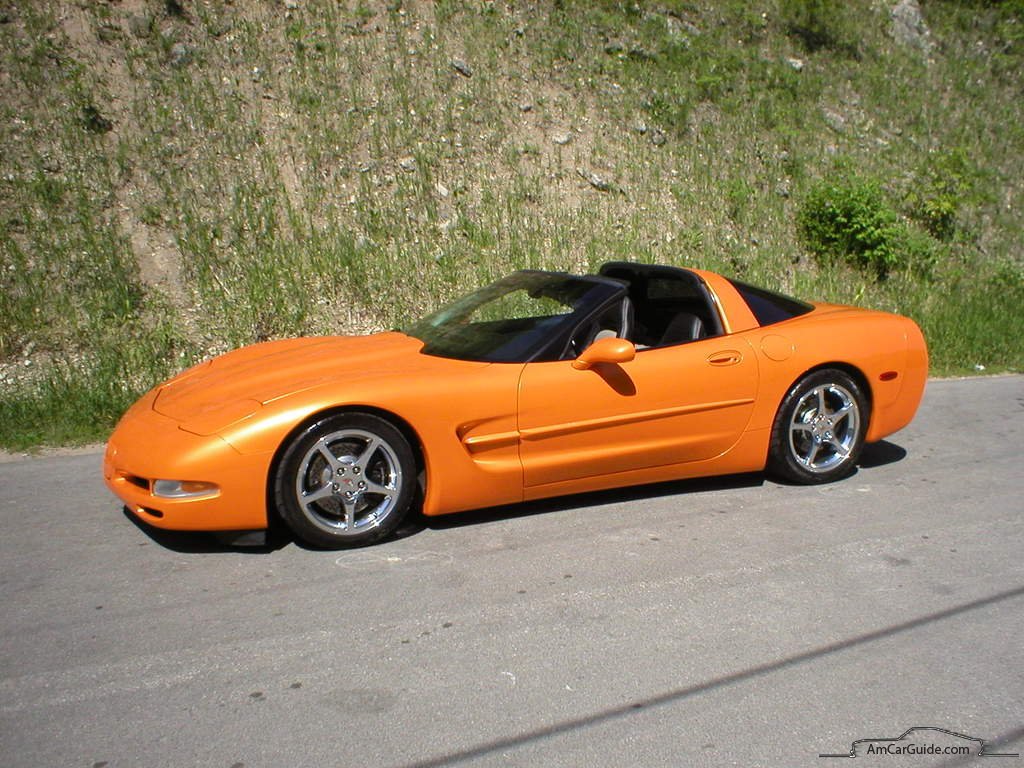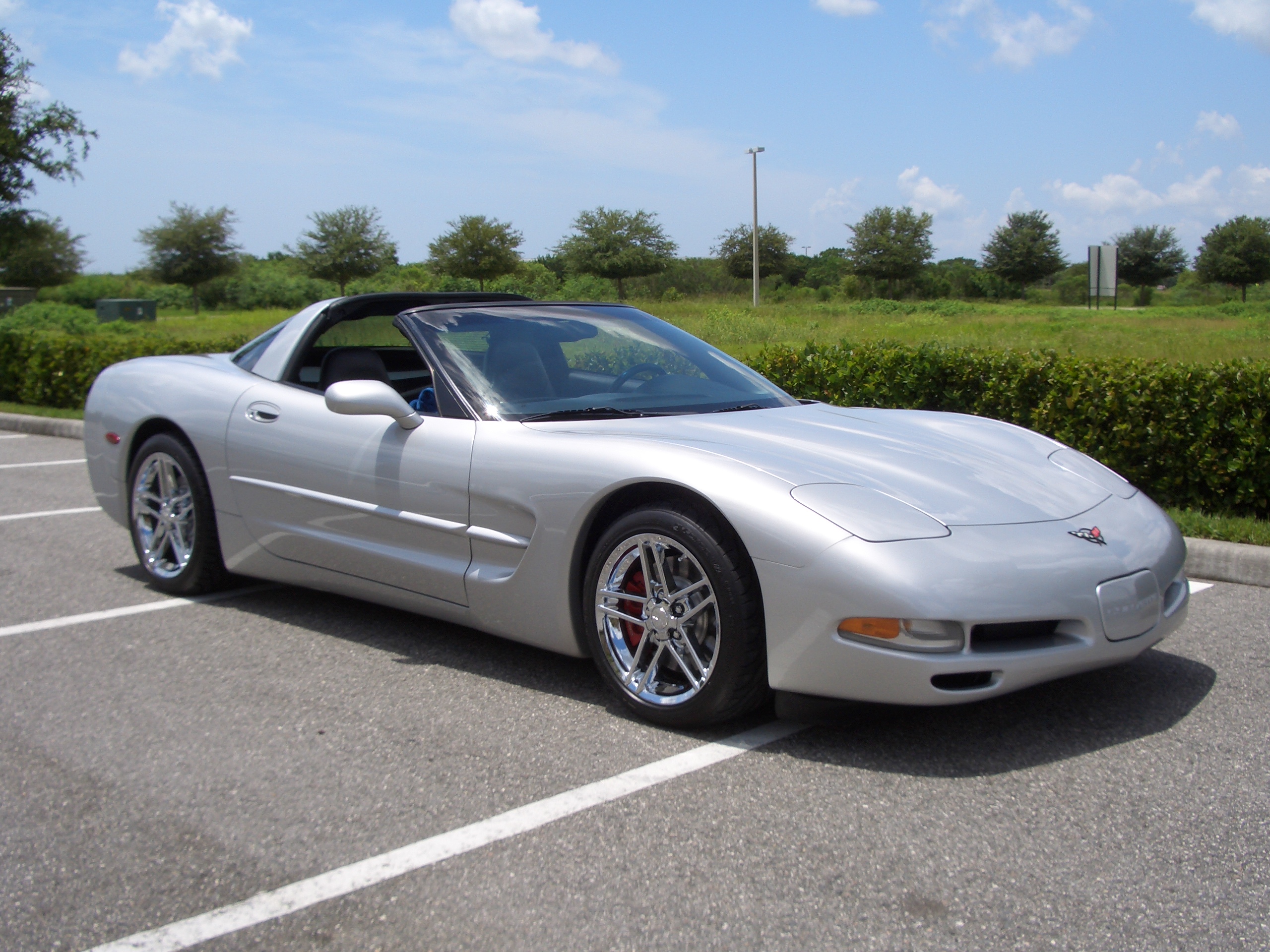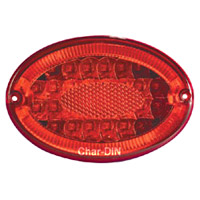The first generation Corvette was introduced late in the 1953 model year and ended in 1962. Often referred to as the "solid-axle" models because the independent rear suspension did not debut until the 1963 Sting Ray. 300 hand-built polo white Corvette convertibles were produced for the 1953 model year. The 1955 model offered the 265 cu in (4.34 L) V8 engine as an option; however, the first seven off the production line featured the standard "Blue Flame" Inline-6. The origin of the Chevrolet Nomad was a two-door wagon concept car built off a 1954 Corvette.

Chevrolet Corvette C5 (1997)

Chevrolet Corvette C5 (1997)
A new body was introduced for the 1956 model featuring a new "face" and side coves; the taillamp fins were gone. An optional fuel injection system was made available in the middle of the 1957 model year. It was one of the first mass-produced engines in history to reach 1 bhp (0.75 kW) per cubic inch (16.4 Cubic cm) and Chevrolet's advertising agency used a "one hp per cubic inch" slogan for advertising the 283 bhp (211 kW) 283 cu in (4.64 L) Small-Block engine. Other options included power windows (1956), hydraulically operated power convertible top (1956), four speed manual transmission (late 1957), and heavy duty brakes and suspension (1957).

1997 Chevy Corvette C5-345 HP
The 1958 Corvette received a body and interior freshening including a longer front end with quad headlamps, bumper exiting exhaust tips, a new steering wheel and dashboard with all gauges mounted directly in front of the driver. Exclusive to the 1958 model were hood louvers and twin trunk spars. The 1959–60 model years had few changes except a decreased amount of body chrome and more powerful engine offerings.

Chevrolet Corvette C5 1997
For 1961, a complete redesign was made to the rear of the car; a "duck tail" with four round lights. The light treatment would continue for all following model year Corvettes. In 1962, the Chevrolet 283 cu in (4.64 L) Small-Block was enlarged to 327 cu in (5.36 L) and produced a maximum of 340 bhp (250 kW) making it the fastest of the C1 generation. 1962 was the last year for the wrap around windshield, solid rear axle, and convertible-only body style. The trunk lid and exposed headlamps did not reappear for many decades.

Chevrolet Corvette C5

Chevrolet Corvette: 1997-2004,
The second generation Corvette referred to as mid-years was designed by Larry Shinoda with major inspiration from a previous concept design called the "Q Corvette" by Peter Brock and Chuck Pohlmann under the styling direction of Bill Mitchell. The design had several inspirations. The first was the contemporary Jaguar E-Type, one of which Bill Mitchell owned and enjoyed driving frequently. Mitchell also sponsored a car known as the "Mitchell Sting Ray" in 1959 because Chevrolet no longer participated in factory racing. This vehicle had the largest impact on the styling of this generation, although it had no top and did not give away what the coupe would look like. The third inspiration was a Mako Shark Mitchell had caught while deep-sea fishing.

1997 Chevrolet Corvette C5

Chevrolet Corvette C5 1997-

1997-04 Chevy Corvette C5 RK
Production started for the 1963 model year and ended in 1967. Introducing a new name, "Sting Ray", the 1963 model was the first year for a Corvette coupe and it featured a distinctive tapering rear deck (a feature that reappeared on the 1971 "Boattail" Buick Riviera) with, for 1963 only, a split rear window. The Sting Ray featured hidden headlamps, non-functional hood vents, and an independent rear suspension. Duntov never liked the split rear window because it blocked rear vision, but Mitchell thought it to be a key part of the entire design. Maximum power for 1963 was 360 bhp (270 kW) and was raised to 375 bhp (280 kW) in 1964. Options included electronic ignition, the breakerless magnetic pulse-triggered Delcotronic first offered on some 1963 Pontiac models. On 1964 models the decorative hood vents were eliminated and Duntov got his way with the split rear window changed to a full width window.

1997 Chevrolet Corvette [C5]

1997 corvette coupe 1997
Four-wheel disc brakes were introduced in 1965, as was a "big block" engine option, the 396 cu in (6.49 L) V8. Side exhaust pipes were also optional in 1965 and continued through 1967. The introduction of the 425 bhp (317 kW) 396 cu in (6.49 L) big block in 1965 spelled the beginning of the end for the Rochester fuel injection system. The 396 cu in (6.49 L) option cost US$292.70 while the fuel injected 327 cu in (5.36 L) engine cost US$538.00. Few people could justify spending US$245.00 more for 50 bhp (37 kW) less, even if the FI cars offered optional bigger brakes not available on carbureted models. With only 771 fuel-injected cars built in 1965, Chevrolet discontinued the option the following year. For 1966, Chevrolet introduced an even larger 427 cu in (7.00 L) Big Block version. Other options available on the C2 included the Wonderbar auto-tuning AM radio, AM-FM radio (mid-1963), air conditioning (late-1963), a telescopic steering wheel (1965), and headrests (1966).

Chevrolet Corvette C5

1997 Chevrolet Corvette C5

Chevrolet Corvette C5

1997 Chevrolet Corvette C5

1997-2004 Chevrolet Corvette

Chevrolet Corvette C5 (1997)

Chevrolet Corvette C5 (1997)
A new body was introduced for the 1956 model featuring a new "face" and side coves; the taillamp fins were gone. An optional fuel injection system was made available in the middle of the 1957 model year. It was one of the first mass-produced engines in history to reach 1 bhp (0.75 kW) per cubic inch (16.4 Cubic cm) and Chevrolet's advertising agency used a "one hp per cubic inch" slogan for advertising the 283 bhp (211 kW) 283 cu in (4.64 L) Small-Block engine. Other options included power windows (1956), hydraulically operated power convertible top (1956), four speed manual transmission (late 1957), and heavy duty brakes and suspension (1957).

1997 Chevy Corvette C5-345 HP
The 1958 Corvette received a body and interior freshening including a longer front end with quad headlamps, bumper exiting exhaust tips, a new steering wheel and dashboard with all gauges mounted directly in front of the driver. Exclusive to the 1958 model were hood louvers and twin trunk spars. The 1959–60 model years had few changes except a decreased amount of body chrome and more powerful engine offerings.

Chevrolet Corvette C5 1997
For 1961, a complete redesign was made to the rear of the car; a "duck tail" with four round lights. The light treatment would continue for all following model year Corvettes. In 1962, the Chevrolet 283 cu in (4.64 L) Small-Block was enlarged to 327 cu in (5.36 L) and produced a maximum of 340 bhp (250 kW) making it the fastest of the C1 generation. 1962 was the last year for the wrap around windshield, solid rear axle, and convertible-only body style. The trunk lid and exposed headlamps did not reappear for many decades.

Chevrolet Corvette C5

Chevrolet Corvette: 1997-2004,
The second generation Corvette referred to as mid-years was designed by Larry Shinoda with major inspiration from a previous concept design called the "Q Corvette" by Peter Brock and Chuck Pohlmann under the styling direction of Bill Mitchell. The design had several inspirations. The first was the contemporary Jaguar E-Type, one of which Bill Mitchell owned and enjoyed driving frequently. Mitchell also sponsored a car known as the "Mitchell Sting Ray" in 1959 because Chevrolet no longer participated in factory racing. This vehicle had the largest impact on the styling of this generation, although it had no top and did not give away what the coupe would look like. The third inspiration was a Mako Shark Mitchell had caught while deep-sea fishing.

1997 Chevrolet Corvette C5

Chevrolet Corvette C5 1997-

1997-04 Chevy Corvette C5 RK
Production started for the 1963 model year and ended in 1967. Introducing a new name, "Sting Ray", the 1963 model was the first year for a Corvette coupe and it featured a distinctive tapering rear deck (a feature that reappeared on the 1971 "Boattail" Buick Riviera) with, for 1963 only, a split rear window. The Sting Ray featured hidden headlamps, non-functional hood vents, and an independent rear suspension. Duntov never liked the split rear window because it blocked rear vision, but Mitchell thought it to be a key part of the entire design. Maximum power for 1963 was 360 bhp (270 kW) and was raised to 375 bhp (280 kW) in 1964. Options included electronic ignition, the breakerless magnetic pulse-triggered Delcotronic first offered on some 1963 Pontiac models. On 1964 models the decorative hood vents were eliminated and Duntov got his way with the split rear window changed to a full width window.

1997 Chevrolet Corvette [C5]

1997 corvette coupe 1997
Four-wheel disc brakes were introduced in 1965, as was a "big block" engine option, the 396 cu in (6.49 L) V8. Side exhaust pipes were also optional in 1965 and continued through 1967. The introduction of the 425 bhp (317 kW) 396 cu in (6.49 L) big block in 1965 spelled the beginning of the end for the Rochester fuel injection system. The 396 cu in (6.49 L) option cost US$292.70 while the fuel injected 327 cu in (5.36 L) engine cost US$538.00. Few people could justify spending US$245.00 more for 50 bhp (37 kW) less, even if the FI cars offered optional bigger brakes not available on carbureted models. With only 771 fuel-injected cars built in 1965, Chevrolet discontinued the option the following year. For 1966, Chevrolet introduced an even larger 427 cu in (7.00 L) Big Block version. Other options available on the C2 included the Wonderbar auto-tuning AM radio, AM-FM radio (mid-1963), air conditioning (late-1963), a telescopic steering wheel (1965), and headrests (1966).

Chevrolet Corvette C5

1997 Chevrolet Corvette C5

Chevrolet Corvette C5

1997 Chevrolet Corvette C5

1997-2004 Chevrolet Corvette
No comments:
Post a Comment